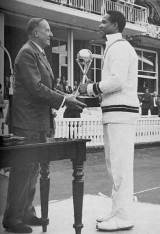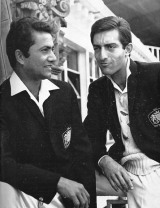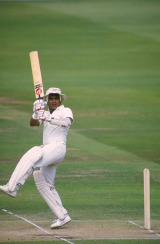A history of the World
Martin Williamson with a brief history of World XI matches
Martin Williamson
07-Oct-2005
|
|

|
Nevertheless, the earliest recorded first-class match featuring a side promoted as a World XI took place at Melbourne in March, 1862, when, rather bizarrely, they took on Surrey. And it was hardly a global side. All but one of the World XI were born in England - John Conway being the exception - and most played regularly in England. It was the only appearance that Thomas
Hearne, the captain, ever made outside England.
The first genuinely representative matches took place in September 1965 when an England XI took on a Rest of the World XI in three-day games at Scarborough and Lord's. The Rest of the World side was selected by readers of the BBC's listing magazine, Radio Times, and 40,000 took part in the poll. There was controversy from the off as Australia's Norman O'Neill withdrew as a protest against the selection of West Indian Charlie Griffith whose action he considered unfair. Given the lateness in the season, it was unsurprising when rain spoiled an interesting finish in the first game and then prevented any play until the second afternoon at Lord's. It was then agreed to play a 70-overs-a-side match, which the World won by nine wickets with Garry Sobers taking 5 for 22.
The following year, the World Cricket Cup, sponsored by Rothmans, was launched. The format was simple. Three sides - England, the touring West Indies, and an impressive Rest of the World XI - playing each other once in 50-over matches at Lord's. The public response was good (13,036 paid over the three days), the weather remained fine, and England beat West Indies in the final. This end-of-season festival was repeated in 1967 when Rest of the World beat Pakistan in the final.
In the spring of that year, a Rest of the World side played Barbados at Bridgetown in a five-day match which was to mark the island's independence. The game was something of a disappointment as Barbados were bowled out for 84 and lost by 262 runs with a day to spare.
In 1968, Rothmans amended the format of their sponsored event. Instead of a triangular one-day tournament, a Rest of the World side played four first-class matches, against Hampshire, Kent, the Australians at Lord's, the final match of their long tour which they won by eight wickets, and then an England XI at Scarborough. The tour was beset by problems from the moment Colin Bland arrived only to be immediately deported, and was not considered a great success.
|
|

|
In 1969 a World XI by another name - they were actually called an International Cavaliers XI - took on New Zealand at Scarborough and won by 11 runs. But the advent of the John Player County League, the first domestic one-day league, meant that the end-of-season Rest of the World games were considered one-day overkill and the concept was dropped. But the interlude was brief.
The cancellation of the South Africa tour to England in 1970 led to the English authorities quickly arranging a five-match series against a Rest of the World side captained by Sobers. The team played only one other match, at the end of the summer, most returning to county commitments in between games. Marketed as Tests, with caps awarded to the England side, only later were they ruled by the authorities not to be. Rest of the World won the series 4-1.
Again it was the scrapping of a South Africa tour - this time to Australia in 1971-72 - which led to the biggest campaign by a world side, undertaking, at short notice, a full tour. Again led by Sobers, Rest of the World fulfilled the commitments which any touring side would have, with five unofficial 'Tests' and seven other first-class matches. After an uncertain start - somewhat unsurprising given that the squad was assembled at little more than a month's notice - the crowds caught on and World XI came from behind to win 2-1. The highlights of the summer were Sobers's brilliant 254 at Melbourne and the emergence of Dennis Lillee as a world-class fast bowler.
In the early to mid 1970s, the International Cavaliers, a quasi- Rest of the World side, regularly toured Rhodesia and South Africa before international sanctions began to bite. In 1973-74, a side billed as Rest of the World, but in essence made up of largely second-string English and West Indian players, played two matches in Pakistan.
The REST OF THE WORLD concept returned with the advent of Kerry Packer's World Series Cricket in 1977. There were enough Australians and West Indians to cobble together two teams, and a third side - the WSC World XI - was fielded from the remnants, although in the first year there were insufficient of those so a few West Indians had to double up. In the second season, the WSC World XI had a far more global feel although it was still made up from England, Pakistan, South Africa and West Indies.
|
|

|
In 1987, MCC celebrated its bicentenary with a five-day match between it and a Rest of the World side which was probably the strongest - and certainly the most representative - up to that point. In front of capacity crowds, bat dominated ball for four days, and a thrilling finale was only scuppered by rain which washed out the final day. The Rest of the World had warmed up with two three-day games at Gloucester and Old Trafford, but the Lancashire match was abandoned without a ball being bowled.
That was the last first-class match involving a genuine Rest of the World side, although there have been an increasing number of one-day matches, almost all for charity, since then. Between 1988 and 1995 various sides labelled as Rest of the World did appear in festival matches in England, but they were rarely representative nor did they feature anything like the best players, more the best who happened not to be doing anything else at the time and were in the country.
The most high-profile matches between 1987 and the advent of the ICC Super Series have been the ones for the Diana Memorial in 1998 and the various Tsunami relief matches in 2005.
Martin Williamson is managing editor of Cricinfo